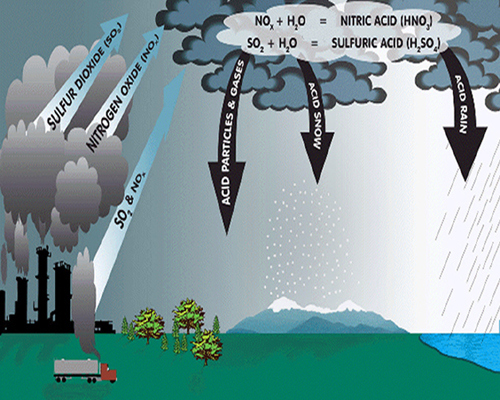Hi everyone! Last week I wrote about air pollution, where it is bad, what causes it, and the main harmful components of air pollution.This week I am going to give you some exact numbers. First, though, let's start with a scary fact. Then I'm moving into how pollution goes away once it is in the air.
US limits on PM2.5 are 12 micrograms per cubic meter averaged over a year. In Europe, the limit is 25. Note that for every increase of 10 micrograms, there is an associated 9% increase in lung cancer incidence, and a .6 years decrease in life expectancy. Scary, right? China has an annual average limit of 40, and India has an annual average limit of 50. They don't do so well in some cases. Beijing averages 56, and Delhi averages 150. In other words, Delhi's population has somewhere in the vicinity of 10 years less of life from air pollution alone.
What about other pollution? SOx, NOx, and ozone tend to accompany each other. Wherever you have SOx, you have the other two. Even clean-burning natural gas power plants produce NOx, just as a by-product of combustion is our nitrogen atmosphere. NOx becomes ozone and smog when mixed with sunlight and organic radicals (the latter of which exist just about everywhere). In other words, these three things are difficult to separate. Moreover, they are often accompanied by PM2.5. Research is having trouble teasing them apart and figuring out what might cause what. But, again, SOx and NOx become strong acids when they react with the water in your lungs, and ozone is toxic to life at ground level (always remember, ozone 15km overhead blocks out the bad parts of the sun, ozone at ground level damages living things).

SOx and NOx, once emitted, are typically cleared out by rainstorms, creating acid rain. It's better than breathing it in, right?
The US has pretty good air quality overall. But if you look at the US government website that shows current levels of pm2.5, you'll see some cities in the US are straight up awful. While their annual average might be around 20-25, on the day I checked, San Bernardino, CA, had 137 micrograms per cubic meter. This is absurdly high. On days like this, people will have difficulty breathing.

Los Angeles on a polluted day. Thanks Curtis Barnes for the correction! Site.
In other words, you can go almost anywhere in the world and find places that are tough to breath in. That being said, there are some countries that are really bad almost everywhere. Bangladesh, India, Nepal, China, and Pakistan are all very polluted. Much of the middle east is as well.
So what makes these things hang out? The most common reasons are inversions. It's when warm air sits on top of colder air. Since air likes to rise when it is warm, if there is a layer of cold air that is polluted that also happens to be capped by warm air, that cold layer will sit there and stagnate. Instead of blowing up or away, it will simply accumulate pollution. Another cause is being surrounded by mountains. Mexico City, for example, is right in the middle of a bunch of mountains. The pollution cannot rise above the mountains, so it lingers and builds. It is also common for coastal areas, or areas next to high deserts, to have times when air refuses to vacate. Those mechanisms are a bit complicated, so we won't discuss them. Finally, being near 30 degrees North or South latitude tends to make air pollution stick around. LA, for example, is at 34 North. The reason for this being bad is that the Earth has the giant airflow patterns. Air is heated at the equator by the sun, then it rises. Eventually it cools and falls near 30 degrees north. The result is that inversions happen more frequently, cause there is air pushing down on the cities.

Diagram of temperature inversion. Site
That's about it for the major causes of air pollution buildup. Of course there has to be pollution to start with for these effects to matter.
Hokay, so, what makes PM2.5 go away when it starts hanging around? Either a wind comes through and blows it out, or a rain comes through. Rain scrubs PM2.5 by absorbing it, and it chemically converts SOx and NOx to acids that become solutes in the rain. Hence acid rain. Also hence why skies are most clear after rains, and how they can smell so fresh and clean after rain. So, if you are going to go for a run in Beijing or Delhi, wait til after a big rainstorm 🙂
Let's talk about that last point a little bit more. China is dry nearly all the time. It doesn't rain much there, so it has a bigger problem of building up air pollution. India has the monsoon season, but is also fairly dry otherwise. What about LA? If you have ever driven in a slight rainstorm in LA, you will see that everyone freaks out and has no clue how to drive in the rain. It's hilarious for about 5 seconds until you realize you are now in a traffic jam. It doesn't rain there, either.
So. Your most polluted places will be near 30 degrees latitude, potentially on the coast or in mountains, dry, and in the vicinity of polluting vehicles, industry, or power plants. Neat. right? I bet you thought it was just pollution alone that caused pollution to linger.
Hokay, that's all for now. Thanks for reading!
- Jason Munster
